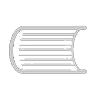Please do not block ads on our site. Clicks on ads help us exist, grow and become more useful for you!
Noise of the pump
The noise of a working pump can be divided into basic noises determined by design features and additional noises that arise during operation.
| dB | Noise Level |
|---|---|
| 80 | noisy - sound of a running truck engine |
| 75 | noisy - shouting, laughter |
| 70 | noisy - busy street, vacuum cleaner at a distance of 3 meters |
| 65 | noisy - loud conversation at a distance of 1 meter |
| 60 | noisy - normal conversation |
| 55 | noisy - telephone sound |
| 50 | clearly audible - washing machine |
| 45 | well audible - keyboard sound |
| 40 | well audible - quiet conversation |
| 35 | well audible - muffled conversation |
| 30 | quiet - wall clock |
Basic sources of noise in a pump
- Rolling bearings
- Air cooling of the electric motor
Both basic sources of noise in a pump are related to the rotational frequency and power of the electric motor. The European standard ISO 3743 limits the noise emitted by the pump during operation depending on the power and rotational frequency of the electric motor.
| Power |
2900 rpm |
1450 rpm |
960 rpm |
| 0.25 |
56 |
41 |
- |
| 0.37 |
56 |
45 |
- |
| 0.55 |
57 |
42 |
40 |
| 0.75 |
56 |
42 |
43 |
| 1.10 |
59 |
50 |
43 |
| 1.50 |
58 |
50 |
47 |
| 2.20 |
60 |
52 |
52 |
| 3.00 |
59 |
52 |
63 |
| 4.00 |
63 |
54 |
63 |
| 5.50 |
63 |
62 |
63 |
| 7.50 |
68 |
62 |
66 |
| 11.0 |
70 |
66 |
66 |
| 15.0 |
70 |
66 |
66 |
| 18.5 |
70 |
63 |
66 |
| 22.0 |
70 |
63 |
66 |
| 30.0 |
71 |
65 |
59 |
| 37.0 |
71 |
66 |
60 |
| 45.0 |
71 |
66 |
58 |
| 55.0 |
71 |
67 |
58 |
| 75.0 |
73 |
70 |
61 |
It is important to remember that an increase in sound pressure by 6 dB(A) is equivalent to doubling the noise level. For example, increasing the sound pressure from 40 to 46 dB(A) is equivalent to doubling the noise level, and from 40 to 52 dB(A) is equivalent to quadrupling it.
As can be seen from the table above, the noise generated by a pump is closely related to the rotational speed of the impeller, so it can only be influenced by reducing the rotational speed. However, reducing the rotational speed also reduces the pump's productivity, so installing a frequency controller can have a significant effect if the pump is selected with a large power reserve, as well as in systems with peak water consumption.
Additional pump noise sources
- Damaged bearing
- Loose pump casing
- Cavitation accompanied by sharp noise and vibration
- Vibration transmitted to enclosing structures and pipelines
Noise from the pump in a residential building
The issue of reducing pump noise has become relevant with the appearance of boiler rooms and heat points in residential buildings equipped with circulation pumps for heating systems and booster pumps for water supply systems.
According to existing building codes, the heat point room should not be adjacent to residential premises, but architects often turn a blind eye to this during the design phase.
The predominant noise in an apartment can be not the basic noise from the pump in the basement, but the noise transmitted through enclosing structures from the vibration of pipelines and through the pump foundation.
Measures to reduce pump noise
- Install a frequency controller for the electric motor. This measure will have a significant effect if the pump is selected with a power reserve or if operating at maximum power is only required during peak hours (for example, in water supply systems).
- Perform sound insulation of the room where the pump is installed.
- If the pump is installed on a foundation, the foundation should be vibration isolated.
- Install anti-vibration inserts on the supply and discharge pipelines to the pump.
- Perform vibration isolation of the supports for pipelines attached to enclosing structures of buildings. Suspended supports should be made hinged, and gaskets made of dense rubber should be placed under the pipeline.
question : comment : feedback
405









 Tutorial Danfoss
Tutorial Danfoss Catalog of
Catalog of 
